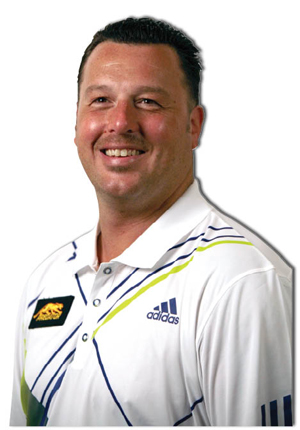|
|
Current Issue
Previous Page Page 2 Next Page
>
Fundamentals of Power
Dennis Hatch
 |
Built like a Mack Truck, Dennis Hatch certainly has the physical tools to detonate the rack. But the real key? Hatch has drilled the fundamentals of his break, so now the timing is something like second-nature. Just another explosive tool in his game's arsenal.
IF YOU think the break is overrated, it's time to think again. Since picking up a cue as a youngster, Hatch has built his game around his break, thanks in large part to his father seeing to it. As Hatch says, "The break's everything. It's huge. If you miss your contact point, if you hit it bad, it might cost you one, two, five games."
So with that being said, starting from the ground up, here are a few tips on building a powerful break.
1. Lay the Foundation
When it comes to getting into your stance, Hatch looks to another sport where power equals results. "I relate pool to boxing," says Hatch, who has a history with the Sweet Science. "When you break the balls, it's like throwing a punch. You pivot off that back foot and you bring everything through."
With his front foot pointing straight at the cue ball, Hatch opens up his back foot so it's perpendicular to his cue. This way, he can put more weight on his back leg, before moving everything toward the cue ball.
But a boxer isn't always throwing everything into every punch. The more power you need from your break, the more you'll have to deviate from your regular stance.
"If I'm going with a softer cut break, I'll get a little lower, so it's closer to a normal shooting stance," Hatch says. "But when I'm really trying to hit 'em hard, I'll stand a little higher. I'll raise my torso a bit and widen my stance."
2. Building a Solid Bridge
No matter what, you need a firm bridge - and bridge arm - to keep your cue moving straight toward the cue ball. Your arm should be bent at a slight angle, with the weight forward on your hand to keep it planted on the table.
If you're breaking from the box, meaning your hand is on the table, you need a steady bridge from start to finish.
"In order to keep your cue straight and steady, try and make your bridge hand as strong as possible," Hatch says. "Believe it or not, I use those hand grippers, those things you squeeze over and over. I'm always using one of those to make my bridge hand stronger."
However, if you're breaking from the side, along the long rail, Hatch implements a little help from the table.
"I like to hang onto the rail with my bridge hand," he says, noting you obviously need to be comfortable with the cue running under your index finger. "I will actually wrap my fingers around the rail and squeeze. That way, I can pull myself off the rail. I can use it to get more leverage."
3. Don't Lose Your Head
Like any in-game shot, you want to keep focused on the contact point on the object ball. But with your upper body involved in the break, your head can't stay completely still.
"I keep my head in position until I start to pivot my body," Hatch says. "I try to move my head as little as possible, because it's harder to stay locked on the contact point.
"But it has to come up with the body, so really focus on keeping your eyes locked on the contact point. A lot of the time, when you're struggling to hit the 1 ball squarely, it's because you're taking your eyes off the ball."
4. Stepping Into Your Stance
Your pre-shot routine doesn't have to be all that complicated. Just get comfy and go from there.
"I put the cue ball down, and I picture the break happening," Hatch says. "I take my front foot, for me that's my right foot, and I take a step towards the cue ball, lining up with the cue ball and the rack. Then I put my cue down, and I step back with by back foot a bit.
"If I feel like my legs are a little off, I'll wiggle my feet into position. Once I feel comfortable and feel my balance point, I know I'm ready to go."
Now it's time to shift your focus from your body to your cue. Considering the number of variables involved in the break, don't be afraid to take your time. You have to make sure a whole host of moving parts is in line.
"Take a few extra strokes," he says. "It takes a lot more focus, with all the body movement and head movement. I like to know everything's in place."
And when he's really busting 'em open, Hatch knows he's that much more dangerous. "If I'm breaking well, the confidence rolls over into my whole game. Obviously, you still need to be able to play if you're not breaking well, but it's just that much harder to get momentum, to get started, to run racks."
Previous Page Page 2 Next Page
>
Top |
|





